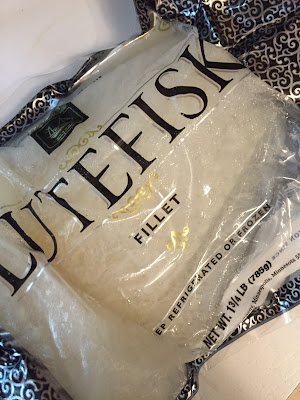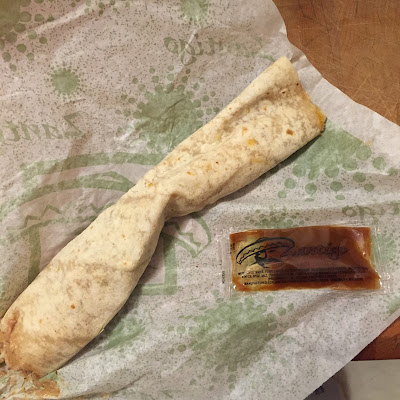Adventures in lutfisk
You say lutefisk, I say lutfisk. The only things Swedes and Norwegians argue about when it comes to our (occasionally) beloved desiccated lye-soaked gelatinous cod is how to pronounce/spell it (Swedes drop the "e") and what to bath it in when ready to dine (Swedes prefer a béchamel sauce, while Norwegians are partial to melted butter).
In general, we agree that eating it is a rite of passage and a nod to those who came before us. Too often we romanticize the lives of our immigrant forebears, imagining them living lives of robust adventure. Eat a serving or two of lutfisk and you realize things weren't always easy. Preserving food with toxins denotes a unique kind of survivalist.
In America the Scandinavians became part of the homogeneous culture relatively quickly. Once their costumes and language changed to suit regional style, not much differentiated them from their European American neighbors. Enter the lutfisk. When we eat lutfisk we celebrate our history, honor our ancestors, and fellowship with those who share this strange and wonderful link. It makes us feel unique.
Not everyone agrees with me. As Swedish Chef Magnus Nilsson quipped while he visited Minneapolis in June, "Why would we eat lutfisk when we can enjoy fresh cod right out of the sea?"
America is that rare place where very few of us can say we and our people have been "from" here for more than a handful of generations. That would be hard to wrap your head around if you lived in the same area that your grandparents, great-grandparents. great great-grandparents, etc. claimed. How do we self-identify? Am I a Swedish American? Am I French English American? A Midwesterner? A Minnesotan? Simply American? Immigration and identity are topics of increasing importance as many nations negotiate issues that come with modern migration.
Last week a group from the BBC visited Minnesota to hear our thoughts about being descendants of an immigrant people. They filmed an episode of Great American Railway Journeys (a spin-off of Great British Railway Journeys) at the American Swedish Institute, where host Michael Portillo spoke with ASI President and CEO Bruce Karstadt about the history of Swedish immigration in our region, joined me in the kitchen to prepare a lutfisk feast, and helped to serve dinner to a dozen guests.
On the menu: lutfisk with a lemony butter sauce, a mustard-kissed béchamel, dilled peas and potatoes, pickled beets and cucumbers, Swedish meatballs, lingonberries, lefse (thank you Norwegian friends!), and rye bread. FIKA supplied a lovely dill aquavit for our skål, and we sang a Swedish drinking song or two. It was a rousing evening!
Busy as I was in the kitchen (with an amazing crew from ASI and FIKA), I didn't catch any images of our supper. Historian and author (and dinner guest) Debbie Miller was kind enough to share her photos with me (see below). I'll post a link to the show once it airs, likely sometime in 2017.
In general, we agree that eating it is a rite of passage and a nod to those who came before us. Too often we romanticize the lives of our immigrant forebears, imagining them living lives of robust adventure. Eat a serving or two of lutfisk and you realize things weren't always easy. Preserving food with toxins denotes a unique kind of survivalist.
In America the Scandinavians became part of the homogeneous culture relatively quickly. Once their costumes and language changed to suit regional style, not much differentiated them from their European American neighbors. Enter the lutfisk. When we eat lutfisk we celebrate our history, honor our ancestors, and fellowship with those who share this strange and wonderful link. It makes us feel unique.
Not everyone agrees with me. As Swedish Chef Magnus Nilsson quipped while he visited Minneapolis in June, "Why would we eat lutfisk when we can enjoy fresh cod right out of the sea?"
America is that rare place where very few of us can say we and our people have been "from" here for more than a handful of generations. That would be hard to wrap your head around if you lived in the same area that your grandparents, great-grandparents. great great-grandparents, etc. claimed. How do we self-identify? Am I a Swedish American? Am I French English American? A Midwesterner? A Minnesotan? Simply American? Immigration and identity are topics of increasing importance as many nations negotiate issues that come with modern migration.
Last week a group from the BBC visited Minnesota to hear our thoughts about being descendants of an immigrant people. They filmed an episode of Great American Railway Journeys (a spin-off of Great British Railway Journeys) at the American Swedish Institute, where host Michael Portillo spoke with ASI President and CEO Bruce Karstadt about the history of Swedish immigration in our region, joined me in the kitchen to prepare a lutfisk feast, and helped to serve dinner to a dozen guests.
On the menu: lutfisk with a lemony butter sauce, a mustard-kissed béchamel, dilled peas and potatoes, pickled beets and cucumbers, Swedish meatballs, lingonberries, lefse (thank you Norwegian friends!), and rye bread. FIKA supplied a lovely dill aquavit for our skål, and we sang a Swedish drinking song or two. It was a rousing evening!
Busy as I was in the kitchen (with an amazing crew from ASI and FIKA), I didn't catch any images of our supper. Historian and author (and dinner guest) Debbie Miller was kind enough to share her photos with me (see below). I'll post a link to the show once it airs, likely sometime in 2017.
Lutfisk in waiting
Table and musicians (image credit: Debbie Miller)
Bread baskets (image credit: Debbie Miller)
Dinner plate (image credit: Debbie Miller)
The party is over
Snacking in FIKA's kitchen










Comments